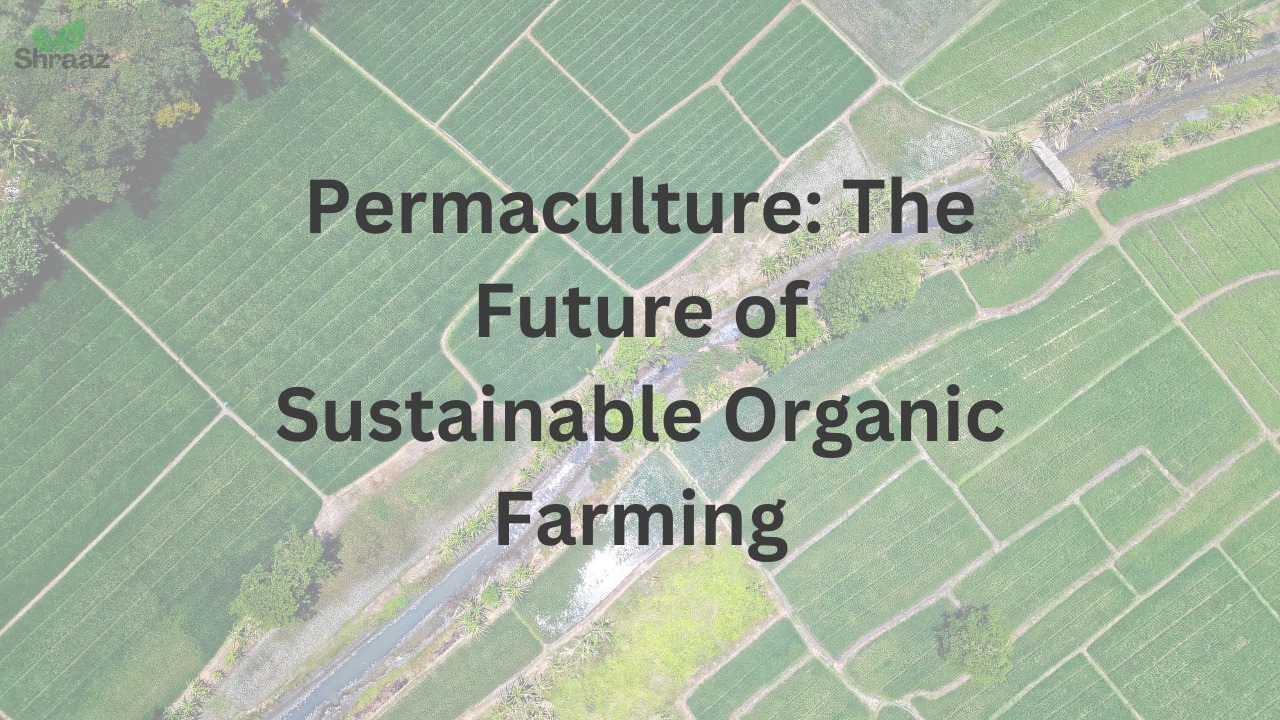Introduction
Permaculture, a term coined in the 1970s by Bill Mollison and David Holmgren, represents a holistic approach to sustainable agriculture. Rooted in the philosophy of working with, rather than against, nature, permaculture seeks to create self-sufficient agricultural systems that integrate human activity harmoniously with the environment. Unlike industrial farming, which often depletes natural resources and damages ecosystems, permaculture focuses on regenerating soil, increasing biodiversity, and reducing dependence on external inputs like chemical fertilizers and pesticides.
The rise of permaculture coincides with growing concerns about climate change, food security, and the environmental degradation caused by conventional farming methods. As more people recognize the need for sustainable practices, permaculture has gained attention as a viable solution for addressing global agricultural challenges while maintaining the ecological balance.
This article will explore the core principles of permaculture, its techniques, benefits, challenges, and real-world applications. By the end, it will become evident why permaculture holds immense promise for the future of sustainable organic farming.
For a broader discussion of overall organic farming beyond just permaculture, check out The Comprehensive Guide to Organic Farming: Principles, Practices, and Future Prospects.
Core Principles of Permaculture
Permaculture is built on three core principles that guide all its practices: Care for the Earth, Care for People, and Fair Share.
1. Care for the Earth
The first principle emphasizes the protection and regeneration of the environment. Soil health, biodiversity, water cycles, and ecosystems must be preserved for long-term sustainability. In contrast to industrial agriculture, which often harms these natural systems through deforestation, soil erosion, and pollution, permaculture promotes practices like no-till farming, mulching, and agroforestry. These techniques help improve soil fertility, enhance water retention, and reduce carbon emissions, contributing to overall environmental restoration.
2. Care for People
The second principle revolves around providing for human needs without exploiting resources or ecosystems. This can be achieved through local food production, self-reliance, and creating resilient communities. In permaculture, the focus is on producing food, shelter, and energy in ways that do not harm the environment or deplete natural resources. The ultimate goal is to improve the quality of life for people by ensuring food security and access to clean water and energy.
3. Fair Share (Return of Surplus)
The third principle acknowledges that there are limits to consumption. The goal is to redistribute surplus resources—whether that is food, energy, or materials—so that they can be reinvested into the system. This could mean composting organic waste, sharing crops with the community, or using surplus energy to benefit future projects. By recycling resources and minimizing waste, permaculture systems can maintain long-term productivity and sustainability.
These core principles create a foundation for building agricultural systems that work in harmony with the natural world while meeting the needs of people. Through careful design and the application of ecological principles, permaculture can offer a model for farming that is both ethical and sustainable.
Key Permaculture Techniques and Practices
Permaculture encompasses a wide array of agricultural techniques, each aimed at creating a more sustainable and resilient system. Here are some of the most important methods used in permaculture:
1. Companion Planting and Polycultures
Permaculture favors polycultures over monocultures. In contrast to traditional industrial agriculture, which often grows single crops over vast areas, polycultures mimic natural ecosystems by planting a variety of crops together. This practice enhances biodiversity, reduces the risk of pest infestations, and improves soil health.
For example, planting legumes alongside other crops helps fix nitrogen in the soil, benefiting the entire system. Companion planting involves growing crops that support each other, such as corn, beans, and squash in a “Three Sisters” arrangement, where each plant fulfills a unique role in the ecosystem.
2. Agroforestry
Agroforestry involves integrating trees and shrubs into farming systems. Trees provide numerous benefits, including reducing soil erosion, improving water cycles, and offering habitats for wildlife. Additionally, they act as windbreaks and help sequester carbon from the atmosphere, contributing to climate change mitigation.
One example of agroforestry is the alley cropping technique, where rows of crops are planted between rows of trees. This method enhances both the biodiversity and resilience of the farm. Farmers can also harvest fruits, nuts, and timber from the trees, providing additional income.
3. No-Till Farming and Soil Regeneration
No-till farming is essential in permaculture to maintain soil health. Unlike conventional farming, which often involves frequent tilling that disrupts soil structure and leads to erosion, no-till farming preserves the natural integrity of the soil. Techniques like mulching and using cover crops help retain moisture, prevent weeds, and improve the soil’s organic matter.
Moreover, permaculture advocates for soil regeneration practices such as composting, vermiculture, and green manure to enhance the fertility and microbiological activity of the soil. Healthy soils are better at retaining water, sequestering carbon, and producing nutrient-rich food.
4. Water Harvesting and Management
Water is a critical resource in permaculture. By using techniques like swales, ponds, and rainwater harvesting, permaculturists can manage water more efficiently, reducing reliance on external irrigation systems. Swales, for example, are trenches dug along the contour of the land that help capture rainwater and direct it into the soil, replenishing groundwater and reducing runoff.
In drier climates, keyline design is used to optimize the distribution of water across the landscape, ensuring that every drop of rain is utilized efficiently. The result is less water waste, healthier plants, and more resilient farming systems.
5. Animal Integration
Animals play an essential role in permaculture systems, as they help fertilize the soil, control pests, and recycle organic waste. Rotational grazing is one technique that allows livestock to graze on different sections of pasture, preventing overgrazing and enhancing the biodiversity of the land.
Chickens, for example, are often used to clear pests from gardens, while their droppings provide valuable nitrogen to the soil. Similarly, goats and sheep can help manage weeds, reducing the need for chemical herbicides.
Table: Comparison of Conventional vs. Permaculture Farming Practices
| Aspect | Conventional Farming | Permaculture Farming |
| Planting Technique | Monoculture | Polyculture |
| Soil Management | Tillage and chemical fertilizers | No-till, composting, organic methods |
| Pest Control | Synthetic pesticides | Natural pest control, companion planting |
| Water Use | Irrigation | Water harvesting, swales, keyline design |
| Biodiversity | Low | High |
| Waste Management | High levels of waste | Recycling of all organic matter |
These techniques not only enhance the resilience and productivity of farms but also demonstrate how permaculture systems mimic natural ecosystems, making them inherently more sustainable than conventional agricultural practices.
Benefits of Permaculture Over Conventional Farming
Permaculture offers numerous benefits over conventional farming systems, particularly in terms of environmental sustainability, economic resilience, and social equity.
1. Environmental Benefits
Permaculture’s ecological approach contributes significantly to reducing the environmental footprint of farming. By avoiding harmful practices like chemical pesticides and synthetic fertilizers, permaculture enhances biodiversity, preserves soil health, and improves the quality of local water sources. Additionally, permaculture systems often act as carbon sinks, sequestering more carbon than they emit, which helps mitigate climate change.
A study published by the International Journal of Agricultural Sustainability showed that farms practicing agroecological methods, such as permaculture, sequester up to 9 tonnes of carbon per hectare per year, whereas industrial farming often contributes to carbon emissions through intensive land use and fossil fuel consumption.
2. Economic Benefits
From an economic standpoint, permaculture offers long-term cost savings and sustainability. Since permaculture systems rely less on external inputs (like synthetic chemicals and energy), farmers can reduce operational costs. Over time, the productivity of a permaculture farm increases as soil fertility improves, biodiversity flourishes, and natural systems take over the functions that would typically require costly intervention.
Additionally, permaculture encourages local economies and community-based food production, reducing the need for expensive transportation and supporting regional food sovereignty. CSA (Community Supported Agriculture) programs are a great example, where consumers buy shares in local farms and receive regular deliveries of fresh produce, helping small farmers maintain steady income.
3. Social and Ethical Benefits
Permaculture promotes an ethical approach to land use, ensuring that resources are used equitably and responsibly. By empowering smallholder farmers and focusing on local food production, permaculture strengthens food security and helps address social inequalities in access to nutritious food.
Moreover, the regenerative design of permaculture systems helps foster stronger, more resilient communities. Neighborhoods that engage in permaculture projects, such as community gardens or urban food forests, often experience a greater sense of community, improved mental well-being, and enhanced local environmental health.
These benefits underscore why permaculture is increasingly seen as the future of sustainable organic farming—by supporting the environment, promoting economic stability, and fostering social equity, permaculture offers a holistic solution to the challenges of modern agriculture.
Challenges and Criticisms of Permaculture
Despite its many advantages, permaculture is not without its challenges and criticisms. These range from practical limitations to broader critiques about its scalability and feasibility on a global level. Understanding these challenges is crucial for those looking to implement or expand permaculture practices.
1. Initial Setup Costs and Labor
One of the primary challenges of permaculture is the initial cost and labor required to establish a system. Implementing key features like swales, ponds, or food forests can require significant investment, both financially and in terms of time and effort. Unlike conventional farming, which often relies on heavy machinery and external inputs, permaculture typically demands more manual labor, particularly in the early stages of setting up the farm.
For smallholder farmers with limited capital, this can be a significant barrier to adopting permaculture. However, proponents argue that over time, these costs are offset by reduced inputs, improved soil health, and the eventual self-sufficiency of the system.
2. Land and Space Requirements
Permaculture practices often require more land area than conventional farming. Techniques such as agroforestry and rotational grazing necessitate larger spaces to allow for biodiversity and animal movement. This can be a limitation in densely populated areas or regions where land is scarce and expensive. While urban permaculture projects (e.g., vertical gardens or rooftop gardens) can mitigate this issue to some extent, scaling permaculture in small spaces is still a challenge for food production at a significant level.
3. Climate and Regional Constraints
Permaculture systems are heavily dependent on local climates and ecosystems, and not all regions are equally suited to every permaculture practice. For instance, while swales work well in areas with periodic rainfall, they may not be as effective in arid or desert climates without significant modification. Similarly, some regions may lack the biodiversity needed to support certain companion planting strategies or food forests.
These regional limitations mean that permaculture must be adapted to local conditions, and a one-size-fits-all approach may not work everywhere. This adaptability requires deep local ecological knowledge, which can sometimes be difficult to acquire, especially in regions with degraded landscapes or extreme climates.
4. Knowledge and Training
Permaculture requires a significant knowledge base and a shift in mindset for many farmers. Unlike conventional farming, where external inputs (e.g., fertilizers, pesticides) can be purchased to solve problems, permaculture demands a deep understanding of ecological principles, plant and animal interactions, and long-term system design.
For farmers accustomed to industrial methods, this transition can be challenging and time-consuming. Moreover, widespread adoption of permaculture will require education and training programs to disseminate the necessary skills and knowledge. Without this, the adoption rate may remain limited to more experienced or environmentally conscious farmers.
5. Criticism of Small-Scale and Local Focus
Another criticism of permaculture is that it often focuses on small-scale farming and local food systems, which some critics argue may not be enough to feed the world’s growing population. Conventional agriculture, with its focus on large-scale monocultures and export-driven production, is often seen as more efficient for meeting global food demands.
However, advocates of permaculture counter this argument by pointing to the long-term sustainability and resilience of permaculture systems, which they believe can support global food security through decentralized, localized production. Furthermore, permaculture’s focus on nutrient-dense, diverse crops can lead to healthier diets and reduce the need for food transportation, which is a significant contributor to greenhouse gas emissions.
Real-World Examples of Permaculture in Action
Permaculture is not just a theoretical framework—it has been successfully implemented in various parts of the world. These real-world examples demonstrate how permaculture can transform landscapes, regenerate ecosystems, and provide sustainable livelihoods.
1. The Greening the Desert Project (Jordan)
One of the most famous examples of permaculture in action is the Greening the Desert project led by Geoff Lawton in Jordan. This project transformed a barren, degraded landscape into a fertile, productive farm using permaculture techniques such as swales to harvest rainwater, companion planting, and agroforestry. Despite the challenging desert climate, the project succeeded in creating a thriving ecosystem, demonstrating that permaculture principles can be adapted even to extreme environments.
2. Zaytuna Farm (Australia)
Located in New South Wales, Zaytuna Farm is a 66-acre permaculture demonstration site founded by Geoff Lawton. The farm features food forests, natural ponds, rotational grazing, and a diverse array of crops and livestock. Zaytuna Farm also serves as a training center, offering permaculture design courses to students from around the world. It showcases how permaculture can be implemented on a medium-scale farm, balancing environmental regeneration with economic viability.
3. La Ferme du Bec Hellouin (France)
In France, La Ferme du Bec Hellouin is a prime example of how permaculture can be used to create a high-yield, small-scale farm. The farm employs intensive permaculture techniques, including no-till gardening, mulching, and polyculture, to grow a wide variety of crops on just 1.5 hectares of land. Studies have shown that the farm’s productivity rivals that of conventional agriculture, while using fewer inputs and regenerating the soil.
4. Syntropic Farming (Brazil)
Syntropic farming, a system closely related to permaculture, has been successfully implemented in Brazil to restore degraded landscapes. Developed by Ernst Götsch, this method emphasizes tree planting, agroforestry, and soil regeneration to create highly productive farms in previously barren areas. By focusing on biodiversity and ecological resilience, syntropic farming has become a key tool for reforestation efforts in Brazil’s Atlantic Forest.
These examples highlight how permaculture can be adapted to various climates, cultures, and economic contexts. Whether in the deserts of Jordan or the rainforests of Brazil, permaculture offers a practical and scalable solution to some of the most pressing challenges in modern agriculture.
Permaculture as a Future Solution for Organic Farming
Permaculture has the potential to shape the future of organic farming by addressing many of the limitations of conventional agriculture and enhancing the sustainability of food systems. Its principles of ecological design, resource efficiency, and resilience make it particularly suited for the future challenges of climate change, food security, and environmental degradation.
1. Climate Resilience
As the effects of climate change intensify, farmers will increasingly need to adapt to unpredictable weather patterns, droughts, floods, and soil degradation. Permaculture’s focus on regenerative practices, such as soil building, water conservation, and biodiversity enhancement, can help farms become more resilient to these changes. By creating self-sustaining ecosystems, permaculture farms are better able to withstand environmental shocks while continuing to produce food.
2. Reducing Dependency on External Inputs
One of the key advantages of permaculture is its emphasis on self-reliance and reducing dependency on external inputs like chemical fertilizers, pesticides, and fossil fuels. As the cost of these inputs rises and their negative environmental impacts become more apparent, permaculture’s low-input systems offer a more sustainable and economically viable alternative. By relying on natural processes to fertilize the soil, control pests, and manage water, permaculture can significantly reduce the environmental and financial costs of farming.
3. Enhancing Food Security
In the future, food security will be a major concern as populations grow and arable land decreases. Permaculture’s focus on local food systems and diverse, nutrient-dense crops can play a critical role in ensuring food security at both the local and global levels. By encouraging decentralized, community-based food production, permaculture can reduce the vulnerability of food systems to global market fluctuations, transportation disruptions, and climate-related crop failures.
Moreover, by promoting urban permaculture and small-scale farming, cities can become more self-sufficient in food production, reducing the pressure on rural agricultural systems and decreasing the carbon footprint of food transportation.
Steps for Transitioning to Permaculture
Transitioning from conventional farming to permaculture can be a gradual process that requires careful planning and commitment. The following steps can help guide farmers and landowners through the transition:
1. Assess the Land and Ecosystem
The first step in transitioning to permaculture is conducting a thorough assessment of the land, its soil quality, water availability, climate, and existing biodiversity. This helps in designing a system that works with the natural ecosystem rather than against it.
2. Design a Permaculture Plan
Based on the land assessment, farmers should develop a permaculture design plan that incorporates key principles such as water management, crop rotation, companion planting, and agroforestry. It’s essential to start with a small section of the land to experiment with permaculture practices before scaling up.
3. Start with Soil Regeneration
Soil health is the foundation of any successful permaculture system. Begin by applying no-till farming methods, introducing compost, green manure, and cover crops to regenerate the soil. Building healthy, fertile soil will improve crop yields and resilience over time.
4. Implement Water Conservation Techniques
Installing swales, ponds, and rainwater harvesting systems is a crucial step in making a farm more water-efficient. These techniques help reduce dependence on irrigation and ensure that water is used effectively throughout the system.
5. Introduce Polyculture and Agroforestry
Once the soil and water systems are in place, begin diversifying the crops through polyculture and agroforestry practices. Planting a variety of crops in the same space, alongside trees and shrubs, increases biodiversity, enhances soil health, and improves the overall resilience of the farm.
6. Gradually Reduce External Inputs
As the farm becomes more self-sustaining, gradually reduce reliance on external inputs like chemical fertilizers and pesticides. Use natural alternatives like compost, beneficial insects, and organic mulches to maintain soil fertility and pest control.
7. Continual Learning and Adaptation
Permaculture is a dynamic and evolving system that requires continual learning and adaptation. Farmers should stay informed about new techniques, experiment with different approaches, and be prepared to adjust their systems as needed.
Conclusion
Permaculture represents a transformative approach to organic farming, one that emphasizes ecological harmony, resilience, and sustainability. By focusing on regeneration rather than extraction, permaculture offers a viable alternative to the industrial agricultural systems that dominate the global food landscape today. While there are challenges to its widespread adoption, particularly in terms of initial costs, labor, and knowledge requirements, the long-term benefits—both for the environment and for farmers—make it a promising solution for the future of food production.
As climate change, soil degradation, and resource scarcity continue to pose existential threats to traditional farming methods, permaculture’s holistic, low-input, and regenerative principles are likely to play an increasingly important role in shaping a more sustainable and resilient agricultural future.
Frequently Asked Questions (FAQ) About Permaculture
1. What is permaculture?
Permaculture is a sustainable farming system that integrates natural ecosystems and regenerative agricultural techniques. It emphasizes working with nature to create self-sustaining systems that enhance biodiversity, conserve resources, and improve soil health. Unlike conventional agriculture, which often focuses on monocultures and external inputs like fertilizers and pesticides, permaculture promotes polycultures, companion planting, and soil-building practices.
2. How is permaculture different from organic farming?
While both permaculture and organic farming avoid synthetic chemicals and focus on sustainable practices, permaculture goes beyond organic farming by emphasizing whole-system design and self-sufficiency. Organic farming typically refers to the method of growing crops without synthetic inputs, but it may still rely on external resources like irrigation or organic fertilizers. In contrast, permaculture aims to create closed-loop systems where inputs (such as nutrients and water) are generated within the farm itself.
3. Can permaculture feed the world’s growing population?
There is ongoing debate about whether permaculture can meet global food demands. Critics argue that permaculture’s small-scale, localized focus may not provide the high yields required to feed a growing population. However, proponents believe that by decentralizing food production, reducing food waste, and enhancing soil fertility, permaculture can contribute to food security in a sustainable way. Moreover, permaculture emphasizes nutrient-dense, diverse crops, which can lead to healthier diets and improved food quality.
4. Is permaculture economically viable for farmers?
Permaculture can be economically viable, especially in the long term, as it reduces the need for costly external inputs like synthetic fertilizers, pesticides, and irrigation systems. However, the initial costs of setting up a permaculture system—such as implementing water conservation techniques, establishing food forests, or regenerating degraded soils—can be higher than conventional farming. Over time, however, these investments pay off through lower input costs, higher resilience, and increased ecosystem services.
5. What are the core principles of permaculture?
The core principles of permaculture include:
- Care for the Earth: Ensuring that natural systems remain healthy and functional.
- Care for People: Providing for human needs in ways that do not harm the environment.
- Fair Share: Redistributing surplus resources and energy to benefit the environment and communities. These principles are often expanded upon with specific design strategies, such as minimizing waste, promoting biodiversity, and using renewable resources.
6. Can permaculture work in urban environments?
Yes, permaculture can be applied in urban environments through practices like urban gardens, rooftop farming, and vertical gardens. Urban permaculture focuses on maximizing space and using innovative design techniques to grow food, recycle water, and compost waste in cities. While large-scale food production may be challenging in an urban setting, permaculture can still help improve local food security, reduce the urban heat island effect, and increase green spaces in cities.
7. What kind of crops are grown in a permaculture system?
Permaculture systems typically feature a wide variety of crops, including vegetables, fruits, herbs, grains, and trees. Crops are chosen based on the local climate, soil conditions, and ecosystem needs. Polycultures (where multiple crops are grown together) are a hallmark of permaculture because they promote biodiversity, reduce pests, and improve soil fertility. Additionally, many permaculture systems include perennials (plants that live for multiple years) such as fruit trees, nut trees, and medicinal herbs, which contribute to long-term sustainability.
8. What are some common permaculture techniques?
Some common permaculture techniques include:
- Companion planting: Growing plants together that benefit each other, such as pest control or improved growth.
- Swales: Ditches dug on contour to capture rainwater and prevent soil erosion.
- Agroforestry: Integrating trees and shrubs with crops and livestock to improve biodiversity and productivity.
- No-till farming: Avoiding soil disturbance to improve soil health and retain moisture.
- Composting and mulching: Recycling organic matter back into the soil to enhance fertility and moisture retention.
9. What are the biggest challenges of implementing permaculture?
The main challenges of permaculture include:
- Initial setup costs and labor: Establishing a permaculture system can require significant upfront investment in infrastructure (e.g., water systems, soil building) and manual labor.
- Land requirements: Some permaculture practices need larger land areas, which can be challenging for small plots or urban spaces.
- Knowledge: Permaculture requires deep ecological knowledge and a shift in mindset, which can be a learning curve for farmers used to conventional methods.
- Scalability: There is criticism about whether permaculture can be easily scaled up to meet the demands of industrial agriculture.
10. Can I implement permaculture on a small scale, like in my backyard?
Yes, permaculture can be implemented on a small scale, even in a backyard or balcony. You can start with simple practices like composting kitchen waste, growing vegetables in raised beds, or using companion planting techniques to improve plant health. Small-scale permaculture systems are ideal for creating self-sustaining gardens that produce fresh food, improve biodiversity, and reduce waste.
11. Where can I learn more about permaculture?
There are many resources available for learning about permaculture, including online courses, books, and local workshops. Some recommended resources include:
- “Permaculture: A Designers’ Manual” by Bill Mollison
- “Introduction to Permaculture” by Bill Mollison and Reny Mia Slay
- Online courses from the Permaculture Research Institute or Permaculture Design Certification (PDC) programs.




